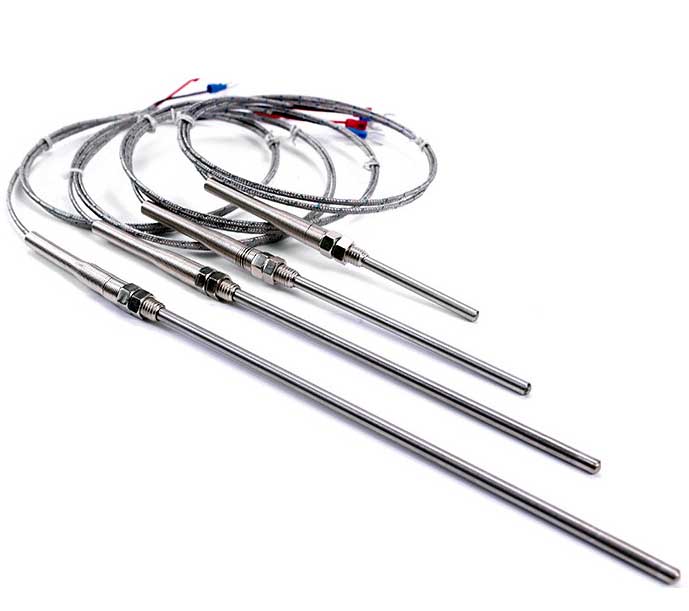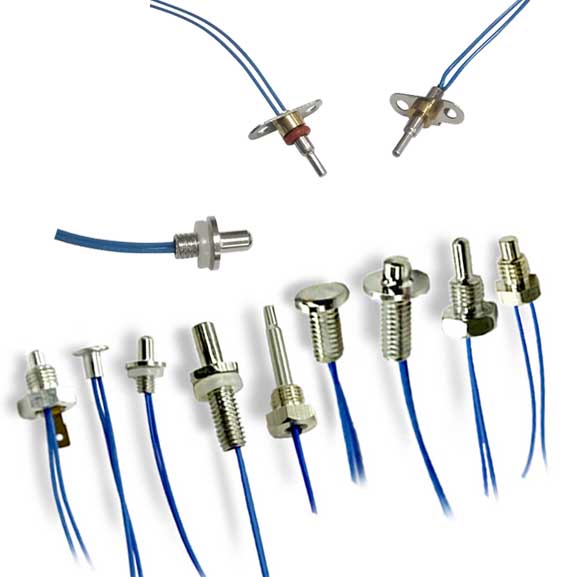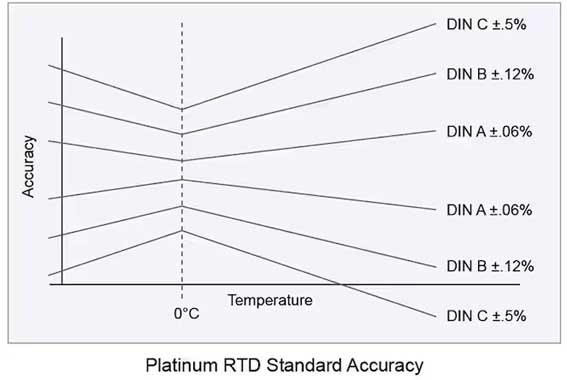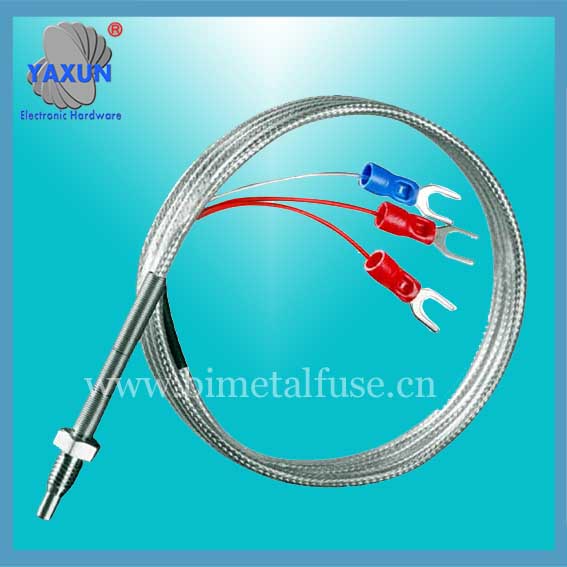Categorias de Produtos
- fusível térmico 32
- fusíveis de montagem em superfície 12
- termistor 36
- Suporte de fusível para montagem em PCB 27
- Chicote de fiação 6
- Porta-fusíveis de lâmina 17
- termostato 50
- Fusível elétrico 24
- Sensor de temperatura automotiva 7
- Disjuntor térmico 22
- Porta-caixa de fusíveis 36
- Sensor de temperatura 75
- Interruptor térmico 68
- Fusível do carro 20
- Fusíveis aparafusados 8
Etiquetas de produto
Sonda de sensor de temperatura rtd pt100 com cabo
O que é um sensor de resistência térmica de platina?
Um IDT (Detector de temperatura de resistência) é uma resistência térmica de platina cuja resistência muda com mudanças de temperatura. Sua resistência aumenta à medida que a temperatura do sensor aumenta. A relação entre resistência e temperatura é bem conhecida e repetível ao longo do tempo. RTD é um dispositivo passivo. Não produz saída por si só. Os eletrônicos externos podem ser usados para medir a resistência ao sensor, passando uma pequena corrente através do sensor para produzir uma tensão. Tipicamente 1 Ma ou menos corrente de medição, máximo 5 mA, sem risco de auto-aquecimento.
Um detector de temperatura de resistência térmica de platina (PT100 RTD) é um sensor usado para medir a temperatura alterando a resistência proporcionalmente à temperatura. O RTD PT100 foi projetado com um elemento básico de temperatura e uma sonda completa e montagem da fiação da fiação. Essas chamadas sondas de RTD consistem em um elemento de resistência térmica de platina, uma bainha ou moradia, Epóxi ou material de enchimento, leads de extensão, e às vezes um conector ou terminação. Diferentes materiais sensores podem ser usados com base nos requisitos do cliente para compatibilidade de material, precisão e faixa de medição. Kits padrão e projetos personalizados fornecem flexibilidade para projetar o sensor de temperatura RTD mais adequado para muitas aplicações diferentes.
RTD PT100 Sensores e sondas podem ser integrados a uma variedade de aplicações em uma variedade de indústrias. Esses sensores de temperatura são certificados por várias agências para operar com componentes de pressão montados em bordo; Eles também podem operar em ambientes severos e perigosos. Nossa ampla gama de opções de produto do sensor de temperatura atendem às necessidades específicas de detecção de aplicativos OEM exigentes, incluindo médicos, Aeroespacial, Automotivo, instrumentação, eletrodomésticos, Controle motor e sistemas de HVAC e refrigeração.
RTD PT100 Tolerâncias padrão
RTDs são construídos para várias curvas e tolerâncias padronizadas. A curva normalizada mais usada é a “DE” curva. Esta curva descreve a resistência versus as características da temperatura da platina com um 100 Ohm Sensor, tolerâncias padronizadas, e faixa de temperatura mensurável.
O padrão DIN especifica uma resistência básica de 100 ohms a 0 ° C e um coeficiente de temperatura de 0.00385 ohms/ohms/° C.. A produção nominal de sensores din rtd é o seguinte:
DIN RTD tem três classes de tolerância padrão. Essas tolerâncias são definidas da seguinte forma:
Din Classe A.: ±(0.15 + 0.002 |T|°C)
DIN CLASSE B.: ±(0.3 + 0.005 |T|°C)
Din Classe c: ±(1.2 + 0.005 |T|°C)
0° C/ ohms
0: 100.00
10: 103.90
20: 107.79
30: 111.67
40: 115.54
50: 119.40
60: 123.24
70: 127.07
80: 130.89
90: 134.70
100: 138.50
Tipo de componente RTD
Ao determinar o tipo de elemento RTD, Primeiro considere o instrumento usado para ler o sensor. Selecione um tipo de componente compatível com a entrada do sensor do instrumento. De longe o RTD mais comumente usado é 100 ohm platina com um coeficiente de temperatura de 0.00385.
Resistor base do tipo de componente (ohms) TCR (ohms/ohms/° C.)
Platina 100 ohms a 0°C .00385
Platina 100 ohms a 0°C .00392
Platina 100 ohms a 0°C .00375
Níquel 120 ohms a 0°C .00672
Cobre 10 ohms a 25 ° C. .00427
Precisão do RTD
Segundo, determinar a precisão da medição necessária. Precisão é uma combinação da tolerância do resistor base (tolerância à resistência à temperatura de calibração) e o coeficiente de temperatura da tolerância ao resistor (tolerância à inclinação característica). Qualquer temperatura acima ou abaixo disso terá uma banda de tolerância mais ampla ou menos precisão (Veja a figura abaixo). A temperatura de calibração mais usada é 0 ° C.
O sensor RTD PT100 está disponível em várias configurações de chumbo diferentes. A configuração mais comum é a configuração de três derivações de um único elemento. Um esquema das configurações de chumbo disponível é mostrado abaixo:
Os sensores de dois fios pt100/pt1000 são normalmente usados em aplicações onde a precisão não é importante. Uma configuração de dois fios permite a técnica de medição mais simples, mas tem imprecisões inerentes devido à resistência dos líderes do sensor. Em uma configuração de dois fios, Não é possível compensar diretamente a resistência ao chumbo que causa maior deslocamento na medição da resistência.
O sensor de três fios PT100/PT1000 possui um circuito de compensação que pode eliminar a resistência do condutor durante a medição. Com esta configuração, o controlador/dispositivo de medição pode realizar duas medições. Para a primeira medição, medir a resistência total do sensor e dos cabos de conexão. Durante a segunda medição, medir a resistência do resistor do circuito de compensação. A resistência líquida real é determinada subtraindo a resistência do circuito de compensação da resistência total. Sensores de três fios são a configuração mais comum e oferecem uma boa combinação de precisão e conveniência.

Sensor de temperatura PT100

Sonda de sensor PT100

Resistência RTD versus Temperatura

Precisão padrão Platinum RTD
A tecnologia de configuração e medição do sensor de quatro fios PT100/PT1000 mede a resistência do sensor sem ser afetada pelos condutores. Embora esta técnica seja mais precisa, muitos controladores/dispositivos de medição industriais são incapazes de obter medições verdadeiras de quatro fios.
A transição dos cabos do sensor para a fiação de campo geralmente é feita no conector que se conecta ao sensor. Blocos terminais são fornecidos para fácil conexão.
Medir a temperatura com um detector de temperatura de resistência é, na verdade, medir a resistência. Uma ponte de Wheatstone desequilibrada é frequentemente usada para medir resistência. Ao medir a resistência de um elemento sensor, todos os fatores externos devem ser minimizados ou compensados para obter uma leitura precisa.
Uma das principais causas de erros pode ser a resistência dos cabos, especialmente em uma configuração de dois condutores.
O resistor está em série com o elemento sensor, então a leitura é a soma do elemento sensor e da resistência do condutor. RTDs de dois condutores podem ser usados quando a resistência do elemento sensor é alta e a resistência dos condutores é baixa.
No entanto, quando a resistência dos cabos é relativamente alta, deve ser compensado. A compensação está disponível em uma configuração de três condutores. Como mostrado no diagrama de três derivações, um lado da fonte de alimentação está conectado a um lado do RTD através de L3. Isso coloca L1 e L2 em lados opostos da ponte, então eles se cancelam e não têm efeito na tensão de saída da ponte.
Recomenda-se usar uma conexão de três condutores para RTDs, especialmente se a resistência do elemento sensor for baixa, onde uma pequena resistência do chumbo pode ter um grande impacto na precisão da leitura.
Contate-nos
Aguardando seu e-mail, responderemos dentro de 12 horas com informações valiosas que você precisava.
 English
English Afrikaans
Afrikaans العربية
العربية বাংলা
বাংলা bosanski jezik
bosanski jezik Български
Български Català
Català 粤语
粤语 中文(简体)
中文(简体) 中文(漢字)
中文(漢字) Hrvatski
Hrvatski Čeština
Čeština Nederlands
Nederlands Eesti keel
Eesti keel Suomi
Suomi Français
Français Deutsch
Deutsch Ελληνικά
Ελληνικά हिन्दी; हिंदी
हिन्दी; हिंदी Magyar
Magyar Bahasa Indonesia
Bahasa Indonesia Italiano
Italiano 日本語
日本語 한국어
한국어 Latviešu valoda
Latviešu valoda Lietuvių kalba
Lietuvių kalba македонски јазик
македонски јазик Bahasa Melayu
Bahasa Melayu Norsk
Norsk پارسی
پارسی Polski
Polski Português
Português Română
Română Русский
Русский Cрпски језик
Cрпски језик Slovenčina
Slovenčina Slovenščina
Slovenščina Español
Español Svenska
Svenska ภาษาไทย
ภาษาไทย Türkçe
Türkçe Українська
Українська اردو
اردو Tiếng Việt
Tiếng Việt

